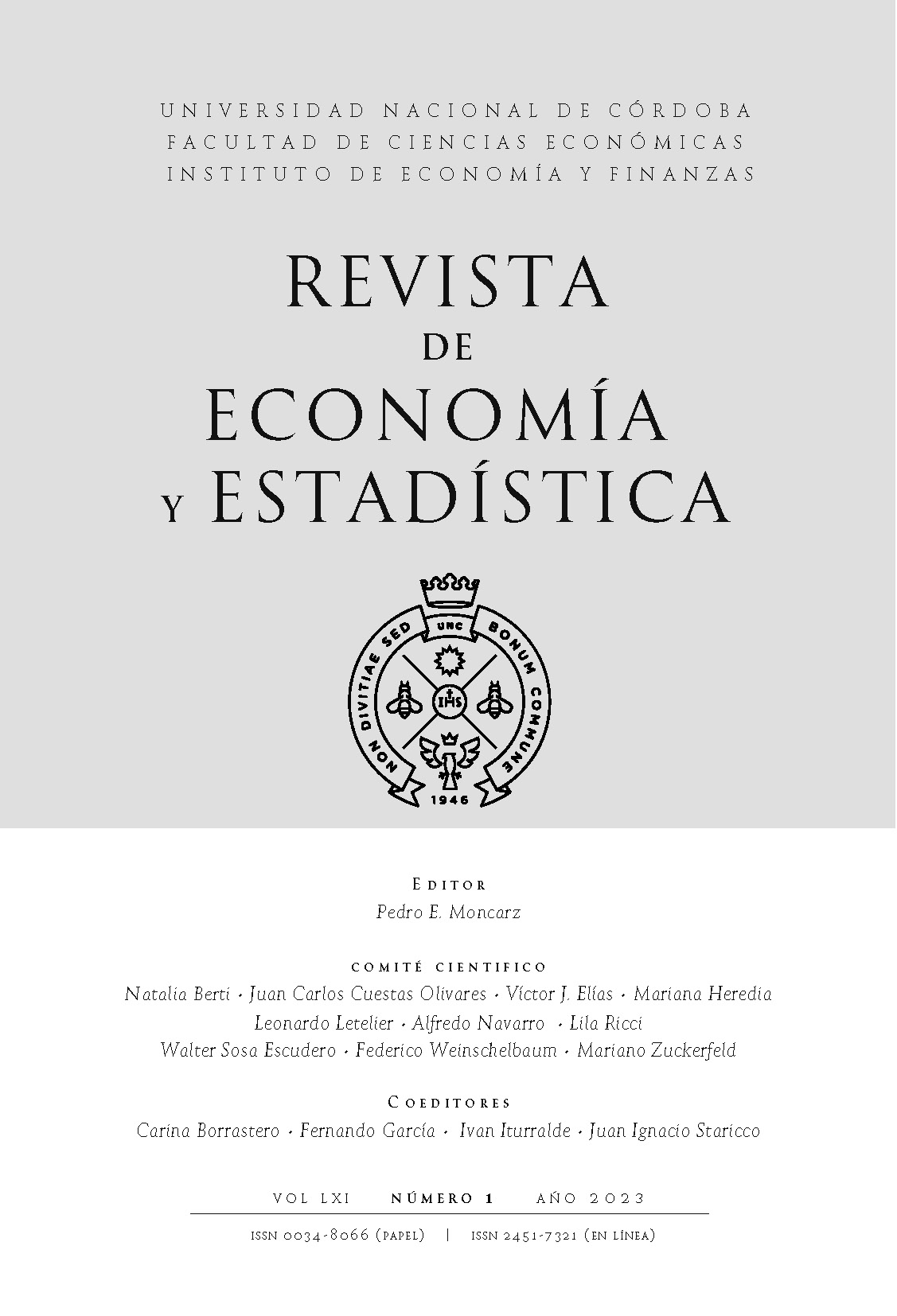Historical Factors of Long-Term Economic Growth and Declination in Argentina: An analysis of the 20th Century
DOI:
https://doi.org/10.55444/2451.7321.2023.v61.n1.44195Keywords:
Long term growth, Economic instability, Argentina, 20th CenturyAbstract
This paper explores the historical long-term determinants of economic growth in Argentina along the XX century. The evidence indicates that at the beginning economic openness plays a key role to explain the successful performance achieved until the great crisis of 1930. From there on, and until the middle of the ´70s, Argentina maintained a similar growth of the previous period, which was driven by the domestic demand via investment. Nonetheless, in the last quarter of the past century economic growth slowed drastically, which was mainly associated with economic instability, approximated by inflation and the per capita growth rate output volatility. The intuition is that once the country lost foreign markets for its exports, could temporarily sustain growth thanks to domestic demand, but once this strategy petered out the economy was signed by a long period of turbulence and stagnation, specifically since 1975 onwards. Thus, economic policy recommendations are to develop new led export-oriented sectors, so that alleviate the external restriction, as to avoid procyclical policies in order to reduce the economic instability.
Reception date: 02/06/2023
Acceptance date: 03/08/2023
Downloads
References
Afonso, A., & Furceri, D. (2010). Government size, composition, volatility and economic growth. European Journal of Political Economy, 26(4), 517-532.
Aisen, A., & Veiga, F. J. (2013). How does political instability affect economic growth? European Journal of Political Economy, 29, 151-167.
Aizenman, J. & Marion, N. (1993). Policy Uncertainty, Persistence and Growth. Review of International Economics, January 1993, 1 (2), pp. 145-63.
Alesina, A., Özler, S., Roubini, N., & Swagel, P. (1996). Political instability and economic growth. Journal of Economic Growth, 1(2), 189-211.
Alagidede, P., & Ibrahim, M. (2017). On the causes and effects of exchange rate volatility on economic growth: Evidence from Ghana. Journal of African Business, 18(2), 169-193.
Astorga, P. (2010). A century of economic growth in Latin America. Journal of Development Economics, 92(2), 232-243.
Awokuse, T. O. (2008). Trade openness and economic growth: is growth export-led or import-led? Applied economics, 40(2), 161-173.
Baglan, D., & Yoldas, E. (2014). Non-linearity in the inflation–growth relationship in developing economies: Evidence from a semiparametric panel model. Economics Letters, 125(1), 93-96.
Bakari, S., & Krit, M. (2017). The nexus between exports, imports and economic growth: Evidence from Mauritania. International Journal of Economics and Empirical Research, 5(1), 10-17.
Balcilar, M., Gupta, R., & Jooste, C. (2014). The Growth-Inflation Nexus for the US over 1801-2013: A Semiparametric Approach. Journal of Applied Economics (No. 15-17).
Bermúdez, C., Dabús, C. , & González, G. (2015). Reexamining the link between instability and growth in Latin America: a dynamic panel data estimation using K-Median clusters. Latin american journal of economics, 52(1), 1-23.
Bittencourt, M. (2012). Inflation and economic growth in Latin America: Some panel time-series evidence. Economic Modelling, 29(2), 333-340.
Bittencourt, M., Van Eyden, R., & Seleteng, M. (2015). Inflation and Economic Growth: Evidence from the Southern African Development Community. South African Journal of Economics, 83(3), 411-424.
Breusch, T. S., & Pagan, A. R. (1979). A simple test for heteroscedasticity and random coefficient variation. Econometrica, 1287-1294.
Bruno, M., & Easterly, W. (1998). Inflation crises and long-run growth. Journal of Monetary economics, 41(1), 3-26.
Buera, F., Navarro, G., & Nicolini, J. P. (2011). The Argentine economy after two centuries. Latin American Journal of Economics, 48(2), 133-156.
Dabús, C. (2000). Inflationary Regimes and Relative Price Variability. Journal of Development Economics, 62 (2), 535-547.
Dabús, C.& Viego, V. (2003). Inflación, Precios Relativos y Crecimiento: Evidencia de América Latina. Estudios de Economía Aplicada, 21 (1), 91-107.
Dabús, C., González, G. & Cecilia Bermúdez (2012): Inestabilidad y Crecimiento Económico en América Latina, in Saúl Keifman, ed., Progresos en Crecimiento Económico, Buenos Aires: Edicon, 117–65.
Dabús, C., Delbianco, F., & Fioriti, A. (2016). High inflation, price stability and hysteresis effect: evidence from Argentina. Revista de Análisis Económico–Economic Analysis Review, 31(1), 59-74.
Dabús, C., & Delbianco, F. (2019). Exports, terms of trade and economic growth: evidence from countries with different level of openness. Journal of Reviews on Global Economics, 8, 327-336.
Davidson, R., & J. G. MacKinnon. (1993). Estimation and Inference in Econometrics. NewYork: Oxford University Press.
De Gregorio, J. (1992). Economic Growth in Latin America, Journal of Development Economics, 39 (1), 59-84.
Dao, A. (2014). Trade openness and economic growth, Illinois Wesleyan University Economics Department Working Papers.
Dickey, D. A., & Fuller, W. A. 1979. Distribution of the estimators for autoregressive time series with a unit root. Journal of the American Statistical Association 74: 427–431.
Fatás, A. & Mihov, I. (2013). Policy Volatility, Institutions, and Economic Growth, The Review of Economics and Statistics, 95 (2), 362-376.
Ferrer, A. (2004). La economía argentina: desde sus orígenes hasta principios del siglo XXI. Buenos Aires: Fondo de Cultura económica.
Ferreres, O. J. (2005). Dos siglos de economía argentina, 1810-2004: historia argentina en cifras. Editorial El Ateneo.
Gerchunoff, P. & Rapetti, M. (2016). La Economía Argentina y su Conflicto Distributivo Estructural (1930-2015), El Trimestre Económico, Vol. LXXXIII (2), 225-272.
Gries, T. & Redlin, M. (2012). Trade Openness and Economic Growth: A Panel Causality Analysis, University of Paderborn working paper.
Gylfason, T. & Herbertsson, T. (2001). Does inflation matter for growth? Japan and the World Economy, 13 (4) (2001), pp. 405–428.
Idris, J., Zulkornain Y. & Muzafar, S. (2016). Trade openness and economic growth: A causality test in panel perspective, International Journal of Business and Society, 17 (2), 281-290.
Hye, Q., Adnan, M. & Wee-Yeap, L. (2015). Trade openness and economic growth: empirical evidence from India, Journal of Business Economics and Management, 16 (1), 188-205.
Hnatkovska, V. & Loayza, N. (2005). Volatility and Growth, in Joshua Aizenman and Brian Pinto, eds., Managing Volatility and Crises: A Practitioner’s Guide, Cambridge: Cambridge University Press.
Hussain, I., Khan, Z. and Rafiq, M. (2017). Compositional Changes in Public Expenditure and Economic Growth: Time Series Evidence from Pakistan, Business and Economic Review, 9 (1), 1-20.
Idris, J., Zulkornain, Y. & Muzafar, S. (2016). Trade openness and economic growth: A causality test in panel perspective, International Journal of Business and Society, 17 (2), 281-290.
Kalyuzhnova, Y. & Patterson, K. (2016). Kazakhstan: long-term economic growth and the role of the oil sector. Comparative Economic Studies 58.1 (2016): 93-118.
Kharusi, S. A., & Ada, M. S. (2018). External debt and economic growth: The case of emerging economy. Journal of Economic Integration, 33(1), 1141-1157.
Khan, M. S., & Ssnhadji, A. S. (2001). Threshold effects in the relationship between inflation and growth. IMF Staff papers, 48(1), 1-21.
Kose, M. A., Prasad, E. S., & Terrones, M. E. (2006). How do trade and financial integration affect the relationship between growth and volatility? Journal of international Economics, 69(1), 176-202.
Kremer, S., Bick, A., & Nautz, D. (2013). Inflation and growth: new evidence from a dynamic panel threshold analysis. Empirical Economics, 44(2), 861-878.
Mbulawa, S. (2017). The impact of economic infrastructure on long term economic growth in Botswana. Journal of Smart Economic Growth, 2(1), 15-33.
Menyah, K., Nazlioglu, S., & Wolde-Rufael, Y. (2014). Financial development, trade openness and economic growth in African countries: New insights from a panel causality approach. Economic Modelling, 37, 386-394.
Minoiu, C., & Reddy, S. G. (2010). Development aid and economic growth: A positive long-run relation. The Quarterly Review of Economics and Finance, 50(1), 27-39.
Musa, A, & Al-Jaberi, Q. (2016): The Relationship between Economic Development and Political Stability: Iraq as a Case Study for the Period 1970-2014, University of Mustansiriya Working Paper.
Pradhan, R. P., Arvin, M. B., Hall, J. H., & Nair, M. (2016). Innovation, financial development and economic growth in Eurozone countries. Applied Economics Letters, 23(16), 1141-1144.
Ojo, O., & Oshikoya, T. (1995). Determinants of long-term growth: Some African results. Journal of African economies, 4(2), 163-191.
Bahmani-Oskooee, M., & Niroomand, F. (1999). Openness and economic growth: an empirical investigation. Applied Economics Letters, 6(9), 557-561.
Otani, I. & Villanueva, D. (1990). Long-Term Growth in Developing Countries and its Determinants: An Empirical Analysis, World Development, 18 (6), 769-783.
Pindyck, R. (1991). Irreversibility, Uncertainty, and Investment. Journal of Economic Literature, September 1991, 29(3), pp. 1110-48.
Ramey, G. & Ramey, V. (1995). Cross-Country Evidence on the Link between Volatility and Growth, American Economic Review 85(5), 1138-51.
Rapoport, M. (2007). Mitos, etapas y crisis en la economía argentina. Nación-Región-Provincia en Argentina, Pensamiento político, económico y social, 9-28.
Sakyi, D., Villaverde, J. & Maza, A. (2015). Trade openness, income levels, and economic growth: The case of developing countries, 1970–2009, The Journal of International Trade and Economic Development, 24 (6), 860-882.
Sala-i-Martin, X., Doppelhofer, G. & Miller, R. (2004). Determinants of Long-Term Growth: A Bayesian Averaging of Classical Estimates (BACE) Approach, The American Economic Review, 94 (4), 813-835.
Simionescu, M., Lazányi, K., Sopková, G., Dobeš, K., & Balcerzak, A. P. (2017). Determinants of economic growth in V4 countries and Romania. Journal of Competitiveness.
Solimano, A. & Soto, R. (2003). Latin American Economic Growth in the late 20th Century: Evidence and Interpretation, Serie Macroeconomía del Desarrollo No. 33, CEPAL.
Soto, R. & Zurita, F. (2011). Two Centuries of Economic Growth in Latin America at its Bicentennial Celebration, Latin America Journal of Economics, 48 (2), 113-132.
Tahir, M. & Azid, T. (2015). The relationship between international trade openness and economic growth in the developing economies: Some new dimensions, Journal of Chinese Economic and Foreign Trade Studies, 8 (2), 123-139.
Tamura, R., Dwyer, J., Devereux, J., & Baier, S. (2019). Economic growth in the long run. Journal of Development Economics, 137, 1-35.
Taylor, A. (1998). On the Costs of Inward-Looking Development: Price Distortions, Growth, and Divergence in Latin America, The Journal of Economic History, 58 (1), 1-28.
Tochkov, K. & Tochkov, K. (2009) .Is Higher Volatility Associated with Lower Growth? Intranational evidence from South Korea, Empirical Economics Letters 8(7): 625-9.
Ulaşan, B. (2015). Trade openness and economic growth: panel evidence, Applied Economic Letters, 22 (2), 163-167.
Vaona, A. & Schiavo, S. (2007). Nonparametric and semiparametric evidence on the long-run effects of inflation on growth, Economic Letters, 94 (3), 452-458.
Vedia-Jerez, D. H., & Chasco, C. (2016). Long-run determinants of economic growth in South America. Journal of Applied Economics, 19(1), 169-192.
Vogiatzoglou, K. & Nguyen, P. (2016). Economic Openness and Economic Growth: a Co-integration Analysis for Asean-5 Countries, The European Journal of Applied Economics, 13 (2), 10-20.
Zeren, F., & Ari, A. (2013). Trade openness and economic growth: A panel causality test. International Journal of Business and Social Science, 4(9).
Downloads
Published
How to Cite
Issue
Section
License
Copyright (c) 2023 Carlos Dabús, Fernando Delbianco

This work is licensed under a Creative Commons Attribution-NonCommercial-NoDerivatives 4.0 International License.
Authors who have publications with this journal agree to the following terms:
Authors retain their copyright and grant the journal the right of first publication of their work, which is simultaneously subject to the Creative Commons Attribution-NonCommercial-NoDerivatives 4.0 International License that allows third parties to share the work provided that its author and first publication in this journal are indicated.
Authors may adopt other non-exclusive licensing arrangements for distribution of the published version of the work (e.g. depositing it in an institutional telematic archive or publishing it in a monographic volume) as long as the initial publication in this journal is indicated.
Authors are allowed and encouraged to disseminate their work via the Internet (e.g. in institutional telematic archives or on their website) before and during the submission process, which can lead to interesting exchanges and increase citations of the published work. (See The Open Access Effect)









